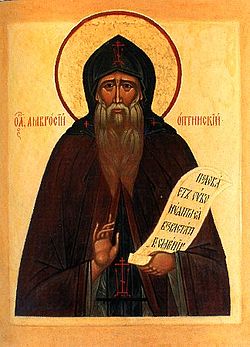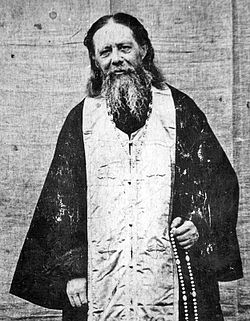Top Qs
Timeline
Chat
Perspective
June 27 (Eastern Orthodox liturgics)
From Wikipedia, the free encyclopedia
Remove ads
June 26 - Eastern Orthodox Church calendar - June 28

All fixed commemorations below celebrated on July 10 by Orthodox Churches on the Old Calendar.[note 1]
For June 27th, Orthodox Churches on the Old Calendar commemorate the saints listed on June 14.
Saints
- Saint Joanna the Myrrhbearer (1st century)[1][2][3][4]
- Martyr Anectus of Caesarea Palaestina (298 or 304)[1][3][5][note 2][note 3]
- Martyrs Therapon, Macarius, Marcius and Marcia.[8][9][10]
- Hieromartyrs Crescens, Maximus, and Theonest, Bishops of Mainz, Germany (early 5th century)[1][11]
- Venerable Sampson the Hospitable of Constantinople (530)[1][3][12][13][note 4][note 5]
- Saint Severus of Interocrea in Italy (Severus d’Antrodoco), presbyter (6th century)[1][11][15][16]
- Hieromartyr Pierius of Antioch, presbyter, by fire.[1][3][17]
- Venerable Luke the Hermit.[3][10][11][18]
Remove ads
Pre-Schism Western saints
- Saint Clement, a martyr in Córdoba in Spain under Diocletian (He belongs to the group led by St Zoilus) (c. 298)[19]
- Saint Zoilus and Companions, a youth martyred in Córdoba in Spain under Diocletian (c. 301)[19][note 6][note 7]
- Saint Deodatus of Nola, Deacon of St Paulinus of Nola in Italy and later his successor (473)[19]
- Saint John of Chinon, born in Brittany, he became a hermit in Chinon in the west of France, where he became the spiritual father of Queen Radegund (6th century)[19][21][note 8]
Remove ads
Post-Schism Orthodox saints
- Saint George of the Holy Mountain and Georgia (1065)[1][11][16][22][23][24]
- Blessed Martin of Turov (after 1146)[1][11][16][25][note 9]
- Martyrdom of Monk Luke (Mukhaidze) of Holy Cross Monastery in Jerusalem (1277)[1]
- New Martyr Iakovos, of Emesa in Syria and of Tripoli in Lebanon, ascetic (15th or 16th century)[9][26]
- Venerable Serapion of Kozhaezersk Monastery (1611)[1][11][16][27][28] (see also: October 19 )
- Hieromartyr Cyril Loukaris, Ecumenical Patriarch of Constantinople (1638)[29][30][31][note 10][note 11][note 12]
New martyrs and confessors
- New Hieromartyr Gregory Nikolsky, priest, of Kuban (1918)[1][9][11][35][36][37][38]
- New Hieromartyr Alexander Sidorov, priest (1918)[9][11][16][35][39]
- New Hieromartyr Vladimir Sergeev, priest (1918)[9][11][16][35][40]
- New Hieromartyr Kirion II, Catholicos-Patriarch of All Georgia (1918)[1][9][11][41][42][43]
- New Hieromartyr Peter Ostroumov, priest (1939)[9][11][16][35][44]
Other commemorations
Icon gallery
- St Joanna the Myrrhbearer, and the Head of St. John the Baptist.
- Cathedral of St. Sampson the Hospitable, in St. Petersburg.
- Venerable George of the Holy Mountain.
- Hieromartyr Cyril Loukaris, Ecumenical Patriarch of Constantinople.
- Venerable Ambrose of Optina.
- Venerable Barsanuphius of Optina.
- Venerable Anatole II of Optina.
Notes
- The notation Old Style or (OS) is sometimes used to indicate a date in the Julian Calendar (which is used by churches on the "Old Calendar").
The notation New Style or (NS), indicates a date in the Revised Julian calendar (which is used by churches on the "New Calendar"). - "At Caesarea, in Palestine, in the persecution of Diocletian, under the governor Urbanus, St. Anectus, martyr. For having exhorted others to suffer martyrdom, and overthrown idols by his prayers, he was scourged by ten soldiers, had his hands and feet cut off, and by decapitation merited the crown of martyrdom."[6]
- "Anectus, martyr at Caesarea, in Cappadocia, in the persecution of Diocletian, was arrested by order of Urban, governor of the province, because he exhorted other Christians to martyrdom, and because he had overthrown several idols in the excess of his zeal. He was condemned to be beaten by ten soldiers, and then to have his hands and feet and head cut off. The date of his martyrdom cannot be fixed exactly."[7]
- "S. Sampson was born of honourable parents, related to the emperor, at Rome. He however lived in Constantinople, where he devoted himself to the care of the sick, for whose accommodation he opened a hospital. Justinian, the emperor, being afflicted with a distressing disorder, which the physicians were unable tc cure, applied to Sampson, who by his touch entirely removed the disease. The emperor in his gratitude would have lavished on him great gifts, but Sampson would accept nothing except a large and commodious building for conversion into a hospital."[14]
- "Zoilus, martyr of Cordova, in Spain, was arrested in the persecution of Diocletian. Alter having endured various tortures, he was decapitated with twenty-nine others. A church was built at Cordova in his honour, and his relics are there preserved. Seven of the company suspiciously enough bear the names of the seven sons of S. Symphorosa, and in the same order."[20]
- See: (in French) Jean de Chinon. Wikipédia. (French Wikipedia).
- See: (in Russian) Мартин Туровский. Википедии. (Russian Wikipedia).
- Hieromartyr Cyril Loukaris (†1638) was honoured as a Saint and Martyr shortly after his martyric death, and the Venerable Saint Eugenios of Aitolia (†1682, August 5) compiled an Akolouthia (Service) to celebrate his memory. The official glorification of Hieromartyr Cyril Loukaris took place by decision of the Holy Synod of the Patriarchate of Alexandria on October 6, 2009.[29][32]
- While Cyril was several times deposed temporarily and banished at the instigation of his orthodox opponents and of the Jesuits, who were his bitterest enemies, his death came suddenly. According to Professor Christos Patrinellis:
"The Catholic Church used all its religious and political influence to destroy this "son of darkness": the Jesuits and Capuchins of Constantinople, the French and Austrian ambassadors, the newly constituted Propaganda Fidei, Pope Urban VIII himself and even Louis XIII and the powerful Cardinal Richelieu. Almost any means of attacking Loukaris were regarded as legitimate because the motive was "sacred": these included threats and violence, bribing Turkish officials and pro-Catholic clerics in the circle of his successor Cyril Kontares, forging texts incriminating Loukaris, and claiming that the patriarch was inciting foreign powers against the Ottoman Empire. The Austrian Embassy planned Loukaris' assas[s]ination or his abduction to Italy and delivered to the Holy Inquisition. Eventually the Austrian ambassador and Kontares persuaded the Sublime Porte to eliminate the patriarch and he was strangled on June 27, 1638."[33]
- Nicodemus the Hagiorite relays this narrative, concerning a certain philosopher named Evagrius, who was an idolater. Through Synesius' efforts, Evagrius and his children were baptized. In order to give thanks, Evagrius gave Synesius 300 gold pieces to distribute to the poor.
- See: (in Russian) Макарий Оптинский. Википедии. (Russian Wikipedia).
- See: (in Russian) Иларион Оптинский. Википедии. (Russian Wikipedia).
- See: (in Russian) Анатолий (Зерцалов). Википедии. (Russian Wikipedia).
- See: (in Russian) Варсонофий Оптинский. Википедии. (Russian Wikipedia).
- See: (in Russian) Анатолий (Потапов). Википедии. (Russian Wikipedia).
Remove ads
References
Sources
Wikiwand - on
Seamless Wikipedia browsing. On steroids.
Remove ads








